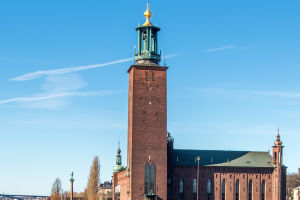The Beyenburger Reservoir is one of the smallest dams in the Bergisches Land region and is operated by the Wupperverband.
It is a popular recreational area frequented by both anglers and walkers.
The nearly flat and lightly traveled paths around the reservoir make it a favored spot for leisurely walks, often combined with a stroll through the streets of Beyenburg. The view over the eastern part of the lake towards the Klosterkirche Sankt Maria Magdalena, situated on the ridge above the Wupper, is one of the most photographed scenes in Wuppertal.
Trails and Recreation
Several trails, including the Wuppertaler Rundweg, the Wupperweg, the Residenzenweg, the Wappenweg, and a route of the Westphalian-Rhine Jacob's Way, run along the shoreline.
During the summer months, the reservoir also serves as a swimming lake. However, swimming is not officially permitted due to dangerous currents. Additionally, a small hydroelectric power plant generates electricity, with a turbine designed for a flow rate of 6.5 m³/s.
Transport and Accessibility
Running parallel to Landesstraße 414 is the Wuppertal railway, which crosses the narrowest point of the lake via a railway bridge. The railway line currently ends in Radevormwald-Wilhelmstal. Parking near the reservoir is generally easy to find, and municipal bus lines provide regular service to both the center of Beyenburg and the reservoir. The Wuppertal railway along the reservoir operates only on certain weekends.
Location and Dimensions
The reservoir is located about eight kilometers southeast of Wuppertal-Barmen, directly adjacent to the district of Beyenburg. It is situated in the Wupper Valley, where the river is dammed. The reservoir stretches over 1,100 meters in length and reaches widths of up to 140 meters; at its northeastern point, it can be as wide as 270 meters. Its capacity is up to 465,000 cubic meters. Due to sediment carried by the Wupper, which can amount to 5,000 m³ annually, there is a risk of siltation, necessitating continuous dredging efforts. The total length, including the dam, is estimated to be around 120 meters. Between June 2009 and autumn 2011, the Wupperverband undertook a major renovation of the dam, which included the construction of a fish ladder to help fish navigate the barrier.
History
The Beyenburger Reservoir was built in its current form between 1950 and 1953 and was put into operation in 1954. It expanded the earlier Beyenburger Compensation Pond, constructed between 1898 and 1900, which had become inadequate for flood protection. Both the original structure and the current reservoir were created primarily for flood protection in the areas of Beyenburg close to the Wupper, as well as to increase water supply during drier seasonal periods. However, this function has largely diminished with the construction of the Wuppertalsperre.
Paddling on the Reservoir
The Wuppertaler Paddler Guild (WPG), the Wuppertal Canoe Club (WKC), and the Canoeing Sports Club (VfK) each have their own boathouses at the lake and collaborate within the KSG Wuppertal for competitive purposes. The VfK hosts the first training group with performance athletes, while the Paddler Guild focuses on advanced paddlers, and the WKC primarily caters to beginners. Through school AGs and especially holiday courses, these clubs aim to attract new talent.
Beyenburger Stausee


